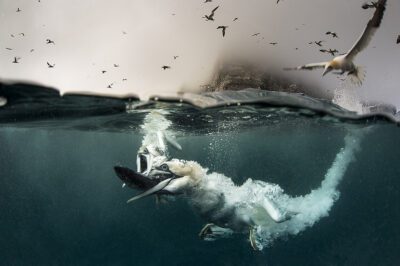
Wild Isles Episode Five: Ocean premieres at 7pm on Sunday 9th April on BBC One and iPlayer.
In the fifth and final episode of Wild Isles, Sir David Attenborough introduces us to the colourful underwater world of Britain and Ireland’s oceans. This episode will take viewers below the waves to uncover the stories of the animals that live along 22,000 miles of our coastline.
Interview with producer Gisle Sverdrup
What would you hope that the audience will take away from watching the series?
I hope that people watching this series will gain a new appreciation of how exciting and surprising the wildlife is on and around the British Isles. The Ocean episode showcases some of the amazingly colourful and charismatic animals living around our islands and I hope that it will change people’s perception of the diversity and importance of our seas.
Why are Britain and Ireland globally important for nature?
The seas around Britain and Ireland are crucially important to many species. The most obvious are our sea birds – 68% of the world population of Northern gannets depend on British and Irish waters*. And a huge number of the world’s population of Manx shearwaters nest on the little island of Skomer, off the Pembrokeshire coast. But other large animals also thrive here – 40% of the world’s grey seals hunt in our seas* and a major part of the global population of Basking sharks come to our shores in summer to feed and breed*. This all depends on the richness of our seas and we need to improve the way we treat our seas if we are to enjoy such wildlife wonders in our waters in the future.
What are the main challenges when filming underwater?
The main challenges for the ocean team were the ever-changing conditions on and in the sea. Sunny days are best for filming, but when working in the water, underwater visibility is also a major factor determining our success. The visibility could change daily, making what was a stunningly beautiful location on one day seem like green soup the next!
Do you think people will be surprised by the species that live in the waters around British and Ireland?
I absolutely believe that people will be surprised by the richness, diversity and colour of our underwater wildlife. What is fantastic is that a lot of it is accessible in shallow water.
And you had an encounter with a mighty basking shark as long as two buses*?
The basking shark is the largest fish in our waters*. This gentle giant might seem threatening, but it only eats some of the smallest inhabitants of the sea – the zooplankton. These are tiny animals and larvae that float around in the water and the basking shark simply has to swim around with an open mouth and collect them. Along the gills of the basking sharks are special sieve-like structures that separate the tiny animals from the sea water.
How did you film the bioluminescence scene? Did you use any new technology?
Bioluminescence is light made by algae and animals in the sea and it is surprisingly abundant in the ocean. But until recently, our cameras have not been light sensitive enough to capture these faint lights. For the bioluminescence sequence in the Ocean episode, we used a newly developed low light camera that could capture the bioluminescence in full 4K resolution.
